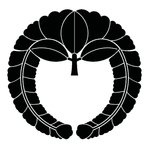Naitō clan
Naitō clan (内藤氏, Naitō-shi) is a Japanese samurai kin group.The clan claims its descent from Fujiwara no Hidesato. The Naitō became daimyōs during the Edo period.[1]
| Naitō clan | |
|---|---|
 Crest of the Naito clan |
History
Under the leadership of Naitō Ienaga (1546-1600), vassal of Tokugawa Ieyasu, in 1590 he was given the Domain of Sanuki (Kazusa Province - 20,000 koku). After Ienaga's death, Naitō Masanaga (1568-1634) succeed him. For his services in Siege of Osaka (1615), he saw his income was 50,000 koku, and then he was transferred to the Iwakidaira Domain (Mutsu Province - 70,000 koku) in 1622. Transferred in 1747 to the Nobeoka Domain (Hyuga Prefecture - 70,000 koku), the Clan remained there until the Meiji Restoration when the Clan leader became a Shishaku (viscount) in the new Kazoku system.
Clan Lords
The Clan suffered several divisions giving rise to the following Branches:
- A branch was established in the Domain of Unagaya (1670-1868) (Mutsu Province - 14,000 koku). Shishaku.
- A branch was established in the Domain of Izumi (Province of Mutsu) in 1628, later it controls the Domain of Annaka (Province of Kozuke) in 1702 and then, in 1748-1868 the Domain of Koromo (Province of Mikawa - 20,000 koku ). Shishaku ..
- The Nobinari Branch was originated by Naitō Nobunari (1545-1612). The son Tokugawa Hirotada and Tokugawa Ieyasu's half-brother who was adopted by Naitō Kiyonaga. He served Ieyasu and, in 1590, when he conquered Nirayama Castle (Izu Province), belonging to the Go-Hōjō Clan, receiving in exchange the Domain of Nirayama with an income of 10,000 koku. In 1601, it was transferred to Sunpu Domain (Suruga Province - 30,000 koku), and in 1606, to Nagahama Domain (Omi Province - 50,000 koku). After his death, this Branch came to live: in 1628 in the Domain of Tanakura (Mutsu Province); in 1705 in the Domain of Tanaka (Suruga Province), and finally between 1720-1868 in Domain of Murakami (Province of Echigo - 50,000 koku).
- Naitō Nobunari (1564-1612)
- Naitō Nobumasa (1612-1626)
- Naitō Nobuteru (1626-1665)
- Naitō Nobuyoshi) (1665-1695)
- Naitō Kazunobu (1695-1725)
- Naitō Nobuteru (1725-1725)
- Naitō Nobuoki (1725-1761)
- Naitō Nobuaki (1761-1762)
- Naitō Nobu (1762-1781)
- Naitō Nobuatsu (1781-1825)
- Naitō Nobuchika (1825-1864)
- Naitō Nobutami (1864-1868)
- Naitō Nobuyoshi (1868-1871)
- A branch was established in the Takatō Domain (Shinano Province - 33,000 koku). Shishaku.
- A branch was established in the Iwamurata Domain (Shinano Province 1693-1868, - 15,000 koku). Shishaku.
- A branch was established in the Domain of Sano (Shimotsuke Prefecture) in 1626, then went to the Domain of Toba (Shima Prefecture - 32,000 koku) in 1634.
Notable members
- Naitō Julia (1566-1627), a Christian convert, she became one of the most prominent Catholic leaders during the Sengoku and early Edo periods, creating a large group of women catechists.
- Naitō Joan (1626), a Christian samurai, he was banned from Japan because of his Christian faith. He and his sister, Naito Julia, were deserted to the Philippines.
References
- Papinot, Jacques Edmond Joseph. (1906). Dictionnaire d'histoire et de géographie du Japon; Papinot, (2003). "Naitō", Nobiliare du Japon, pp. 39–40; retrieved 2013-5-5.